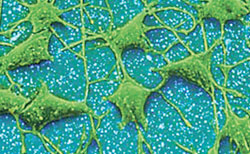US researchers have for the first time encouraged substantial regrowth in nerves controlling voluntary movement after spinal cord injury.
By manipulating an enzyme involved in cell growth, researchers were able to regenerate spinal cord nerves in mice, Nature Neuroscience reports.
It follows similar work on repairing the optic nerve to restore sight.
UK experts said the next challenge would be to turn the findings into a treatment suitable for humans.
The ability to grow new nerve cells is present at birth but then diminishes with age.
It means that after injury or illness to the spine such cells, known as axons, cannot regenerate.
In the latest study the researchers attempted to switch back on the signalling pathway that encourages this new growth in young mammals.
They did it by knocking out a gene called PTEN in mice which in normal circumstances puts a halt on new nerve growth.
The team, from Harvard Medical School and the University of California, Irvine, reported substantial regrowth in severed spinal cords in the animals.
They are now working on tests to see if the technique can actually restore spinal cord function.
Potential treatment
Study author Professor Oswald Steward said: "Until now, such robust nerve regeneration has been impossible in the spinal cord.
"Paralysis and loss of function from spinal cord injury has been considered untreatable, but our discovery points the way toward a potential therapy to induce regeneration of nerve connections following spinal cord injury in people."
Professor James Fawcett, head of clinical neuroscience at Cambridge University, said there was an awful lot of work going on in this area and the results were exciting.
But he pointed out: "It seems to work in young mice but we need to see what happens in older mice.
"We need to make it clear that this is not ready for human patients."
Dr Michael Coleman, from The Babraham Institute in Cambridge added that the challenge would be taking the results and turning them into a treatment that could be used in humans.
"Finding drugs to block the same pathway would be one approach as even gene therapy, which is highly experimental, could not easily 'remove' a gene as they have done so here."
(BBC News) |


